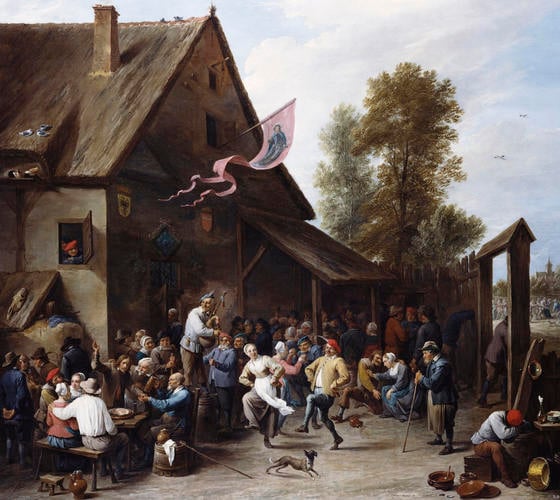-
1 of 253523 objects
A Kermis on St George's Day Signed and dated 1649
Oil on canvas | 79.7 x 88.7 cm (support, canvas/panel/stretcher external) | RCIN 405952
-
This is one of the most perfect of Teniers’s many Kermis scenes and is a conscious tribute to Pieter Bruegel the Elder’s treatments of the subject. Like Bruegel, Teniers creates episodes in which we can recognise the vices of Lechery (in the man molesting a woman to the right of centre), Wrath (two men are kept from each other in the background), drunkenness (in the figure sleeping it off to the lower right) and general boorishness (seen throughout). The mood is much more concerned, however, with characteristic behaviour (the two sealing a bargain to the left), careless folly and comical high spirits, especially in the principal couple dancing with such cheerful and inexpert abandon. The way in which the old man looks on to the left suggests the indulgent wisdom of the village elder.
It is tempting to conclude that this happy scene is a celebration of the Treaty of Munster of 1648 (the year before the painting was executed), which had brought to an end eighty years of war. In the same year as this work (1649) David Ryckaert III (1612-61) clearly alluded to the recent conflict in a pair of paintings called Peasants’ Sorrow and Peasants’ Joy (Kunsthistorisches Museum, Vienna), the former a scene of soldiers plundering and the latter a Kermis like this one. Another version of Teniers’s design (now lost) seems to have been painted for William II, Prince of Orange (1626-50), the stadtholder and Dutch commander-in-chief. A drawing recording the design (Hessisches Landesmuseum, Darmstadt) is inscribed with an instruction to execute a painting from it for ‘His Highness my Lord the Prince of Orange’. This is not the Prince of Orange’s painting, as was once believed; apart from anything else it includes a coat of arms with the double eagle of the Habsburgs - hardly appropriate for a Dutch soldier. The existence of the other version raises the interesting possibility that two versions of this design were created at the time of the truce, one for each of the two sides involved in the war. If so, then the painting perfectly sums up the rural customs and the Bruegelian artistic heritage, which were equally valued by both sides, at the same time as providing an image of harmony and reconciliation.
George IV was typical of his age in setting an especially high value of the works of David Teniers; this work was the most expensive Teniers in his collection, valued in his 1819 inventory at an astonishing 1500 guineas.
Signed and dated lower right: DAVID. TENIERS. F/ AN. 1649
Catalogue entry adapted from Bruegel to Rubens: Masters of Flemish Painting, London, 2007Provenance
Acquired by George IV in 1821; added to the Carlton House inventory dated 1816 (no 585) and 1819 (no 580); in the Picture Gallery at Buckingham Palace in 1841 (no 127)
-
Medium and techniques
Oil on canvas
Measurements
79.7 x 88.7 cm (support, canvas/panel/stretcher external)
100.0 x 109.0 x 8.0 cm (frame, external)
Other number(s)
Alternative title(s)
Peasants feasting and dancing outside a tavern
